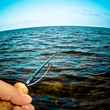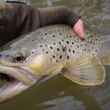For numerous reasons—some good and some bad—the fly fishing industry isn’t content to stand pat with what works. Rod builders churn out new sticks every year, and most rod models don’t hang around particularly long, though a few rods have bucked that trend over the years. Redington’s Classic Trout comes to mind. So does the Orvis Recon.
Upon its debut, the Recon was heralded as perhaps the best mid-priced rod in the industry. Back in the 2016 Yellowstone Angler 5-Weight Shootout, the Recon outranked more highly priced rods like the Scott G2, Winston Boron IIIx, Fenwick Aetos, Sage MOD, Thomas & Thomas Spire, and the Redington Hydrogen. In short, the Recon was punching above its weight while retailing for only $425.
So, when Orvis decided to redesign the Recon, I was anxious. Why bother tweaking a good thing? Could they possibly improve on the original Recon, and still put out a rod that doesn’t break the bank?
The short answer is yes. The longer answer is what follows.
What Works
Weight
The updated Recon (aka the 'Recon 2') is incredibly light – Orvis claims it’s the lightest rod in its class, with the 9’ 5wt model clocking in at 3oz on the dot. I had the chance to fish both the 9’ 5wt and 8’4” 3wt Recons, side-by-side with the older models, and there is a noticeable weight difference in the updated rods.
Obviously, the light weight makes the Recon pleasant to carry around all day, especially if you spend a lot of time hiking.
Tippet Protection
There’s a small spring creek I like to fish year-round here in Utah. It’s full of brown and cutthroat trout, and the water is crystal-clear. Think Idaho’s Silver Creek kind of clear. The fish see you from miles away, which makes fine tippets a must. And, this creek has some decent fish in it. I’ve caught browns up to 20 inches, and cutthroat at 17.
This creek seemed the perfect proving ground for whatever tippet protection the Recon would offer. Both the 5wt and 3wt handled 7x and size 22 dries with aplomb, and the only break-offs I had were my own fault. Even though the rest of the rod action is fast, the tips are soft and slow enough that any broken tippet likely isn’t the rod’s fault.
Quick Action
Personally, I prefer slow to medium-fast rods, but I know I’m in the minority here. The updated Recon kept its fast action, though I think it’s more user-friendly than the original Recon from 2015. The new Recon recovers quickly, dampens well, and really launches line when needed. Even the 3wt was punching line comfortably to 60 feet.
It also has plenty of reserve power, in all the weights, for throwing larger-than-average flies. I use true-to-weight lines on almost all my fly rods, and the two Recons I tested were fished with true-to-weight 3 and 5wt line. Without the added help of a half-heavy line, I was still turning over dry-dropper-dropper rigs without too much work with the 5wt. The 3wt didn’t like those rigs as much, but that’s to be expected. I’ve yet to find a 3wt that does like throwing three flies.
If you do a lot of streamer fishing for trout, then I’d highly suggest looking at the Recon. It has the guts to turn over big meat flies with a well-timed double-haul, and the backbone to tame trout over 20 inches.
Craftsmanship
Orvis took (still takes?) a lot of flak for the big white stickers on the Helios 3 rods. But when you’re watching a fishing video, or out on the river, you can instantly tell who’s using an H3, and who isn’t. And since fly rods are status symbols of a sort, Orvis’ top-of-the-line rods are easily the most recognizable.
The Recon doesn’t sport that same white sticker, but the lettering, font, and blank have all been updated to match the styling of the H3 rods. All of Orvis’ rods have had those updates, save for the Superfine Glass series.
The new Recon features some gorgeous cork that I’m certain Orvis procures through a deal with the devil. I build bamboo rods and still can’t find cork that’s as good as what Orvis has on the Recon and H3.
I love the burled wood insert in the reel seat, and the muted colors of the hardware. The rest of the rod is standard fare — snake guides the length of the rod, a rubber winding check, and anodized aluminum reel seat hardware. The new Recon is an understated stick, which I think a lot of anglers will appreciate. At the very least, it’s a fantastic update over the old Recon, which looked more like something you’d expect to see Indiana Jones carrying if he ever fly fished.
I’ll also note here that Orvis gives the Recon the same 25-year guarantee it does on the H3, and the Recon is also made in the USA.
What Doesn’t Work
No Hook Keep
With every new Orvis rod since the H3, Orvis has omitted a hook keep. Tom Rosenbauer explained to me a few years back that he wanted the hook keep removed so that it wasn’t in the way of shooting line, and the fact that, according to Tom, most anglers tend to hook their flies onto the foot of the stripping guide anyways. Call me old-fashioned, but I prefer the hook keep.
Swing Weight
So far, the only real gripe I’ve had with the Recon in terms of how it actually fishes (the hook keep doesn’t effect on-the-water performance) is the swing weight. If I were to guess at which compromises Orvis had to make to keep the redesigned Recon in the mid-range price tier, I’d point at the rod’s swing weight. By no means is the Recon's swing weight a deal breaker, nor is it out of line with its direct competitors, but you may notice it on long fishing days
Final Word
The updated Recon is faster, lighter, and more pleasant to cast than its predecessor. Surprisingly, Orvis was able to save what was great about the original rod, and incorporate it into a more finely-tuned package. The tippet protection is still there, the reserve power for throwing big bugs or fighting wind didn’t leave, and the overall feel of the rod is largely the same as what made so many anglers fall in love with it five years ago.
While I’d love to have seen the price stay closer to the original $425, the cost of manufacturing in the US has risen in the past half-decade. The fact that Orvis was able to keep the Recon under $500 is impressive, especially considering that it places ahead of flagship rods from other manufacturers in some fly rod shootouts.
Overall, the Recon is a great step up from your entry-level rod and it won’t break the bank. I’m guessing most anglers will enjoy the rod’s many virtues as much – if not more – than its price tag.





























Comments
Lee Ashton replied on Permalink
I owned a 9ft 5wt original Recon for 2 years and despite all the fantastic reviews, I hated it. The blank was thick which I didn't like (I actually took a micrometre to it and found it was as thick at my 8wt meridian) but the biggest problem was the lack of feel. On good days I could put a fly out to 80ft but it took a level of concentration rather than instinct. It just gave no feedback and I didn't find it enjoyable to fish with, I hope this one genuinely is better.
Tahoe Chris replied on Permalink
I have the new Recon 10' 3wt and love it. I use it for euro nymphing and casting dries, and it works great for each. It has a down seating reel lock which is good for balancing the rod and reel for tight-line nymphing. I agree 100% with the reviewer that I miss the hook keeper -- I ended up getting one of those Fuji devices from Amazon to act as hook keeper which works but isn't very elegant.
Ryan Knoup replied on Permalink
Ahhhh the cost of manufacturing generally trends upwards since forever. Spin it how you want, but that’s inflation for you. There may be years that it dips or reacts to crisis such as 2008, but generally speaking, it’s constantly climbing.
Pages